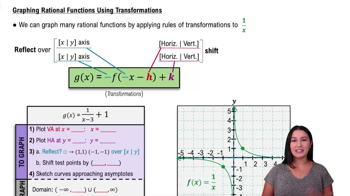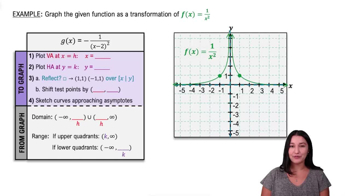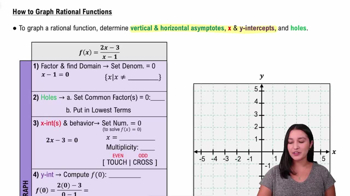Table of contents
- 0. Review of Algebra4h 16m
- 1. Equations & Inequalities3h 18m
- 2. Graphs of Equations43m
- 3. Functions2h 17m
- 4. Polynomial Functions1h 44m
- 5. Rational Functions1h 23m
- 6. Exponential & Logarithmic Functions2h 28m
- 7. Systems of Equations & Matrices4h 6m
- 8. Conic Sections2h 23m
- 9. Sequences, Series, & Induction1h 19m
- 10. Combinatorics & Probability1h 45m
5. Rational Functions
Graphing Rational Functions
Problem 45
Textbook Question
In Exercises 45–56, use transformations of f(x)=1/x or f(x)=1/x^2 to graph each rational function. g(x)=1/(x−1)
 Verified step by step guidance
Verified step by step guidance1
<Step 1: Identify the base function.> The base function here is \( f(x) = \frac{1}{x} \). This is a basic rational function with a vertical asymptote at \( x = 0 \) and a horizontal asymptote at \( y = 0 \).
<Step 2: Determine the transformation.> The given function is \( g(x) = \frac{1}{x-1} \). This represents a horizontal shift of the base function \( f(x) = \frac{1}{x} \) to the right by 1 unit.
<Step 3: Identify the new asymptotes.> Due to the horizontal shift, the vertical asymptote of \( g(x) \) is now at \( x = 1 \). The horizontal asymptote remains at \( y = 0 \) because the transformation does not affect the horizontal asymptote.
<Step 4: Sketch the graph.> Start by sketching the graph of \( f(x) = \frac{1}{x} \), then shift the entire graph to the right by 1 unit to obtain the graph of \( g(x) = \frac{1}{x-1} \).
<Step 5: Verify key points.> Choose a few values of \( x \) around the vertical asymptote (e.g., \( x = 0, 2 \)) to verify the behavior of the graph and ensure it matches the expected transformation.
Recommended similar problem, with video answer:
 Verified Solution
Verified SolutionThis video solution was recommended by our tutors as helpful for the problem above
Video duration:
5mPlay a video:
Was this helpful?
Key Concepts
Here are the essential concepts you must grasp in order to answer the question correctly.
Rational Functions
Rational functions are expressions formed by the ratio of two polynomials. They can exhibit unique behaviors such as asymptotes, intercepts, and discontinuities. Understanding the structure of rational functions is essential for analyzing their graphs, particularly how they behave near critical points like zeros and poles.
Recommended video:

Intro to Rational Functions
Transformations of Functions
Transformations of functions involve shifting, stretching, compressing, or reflecting the graph of a parent function. For example, the function g(x) = 1/(x-1) represents a horizontal shift of the parent function f(x) = 1/x to the right by 1 unit. Recognizing these transformations helps in accurately sketching the graph of the function.
Recommended video:

Domain & Range of Transformed Functions
Asymptotes
Asymptotes are lines that a graph approaches but never touches. For rational functions, vertical asymptotes occur where the denominator is zero, while horizontal asymptotes describe the behavior of the function as x approaches infinity. Identifying these asymptotes is crucial for understanding the overall shape and limits of the graph.
Recommended video:

Introduction to Asymptotes

 5:31m
5:31mWatch next
Master Graphing Rational Functions Using Transformations with a bite sized video explanation from Callie
Start learningRelated Videos
Related Practice




